Life Span and Human Development: Applying Bronfenbrenner's Model
VerifiedAdded on 2020/02/23
|8
|1879
|313
Essay
AI Summary
This essay delves into the intricacies of life span and human development, focusing on Bronfenbrenner's ecological systems theory. It begins by outlining the five interconnected systems of the model: microsystem, mesosystem, exosystem, macrosystem, and chronosystem, explaining how each system influences a child's development through interactions and external factors. The essay then applies Bronfenbrenner's model to Rushton's research, examining the genetic and environmental contributions to prosocial attitudes and behaviors, using twin studies to analyze the heritability of social responsibility. The findings highlight the impact of family-environmental, sex differences, and cultural factors within the various levels of Bronfenbrenner's model, including the microsystem and macrosystem. The paper also references other studies to support the findings and concludes by emphasizing the significance of considering the interplay of these factors in understanding human development. This assignment provides a comprehensive overview of the application of Bronfenbrenner's model in the context of genetic and environmental influences on human behavior.
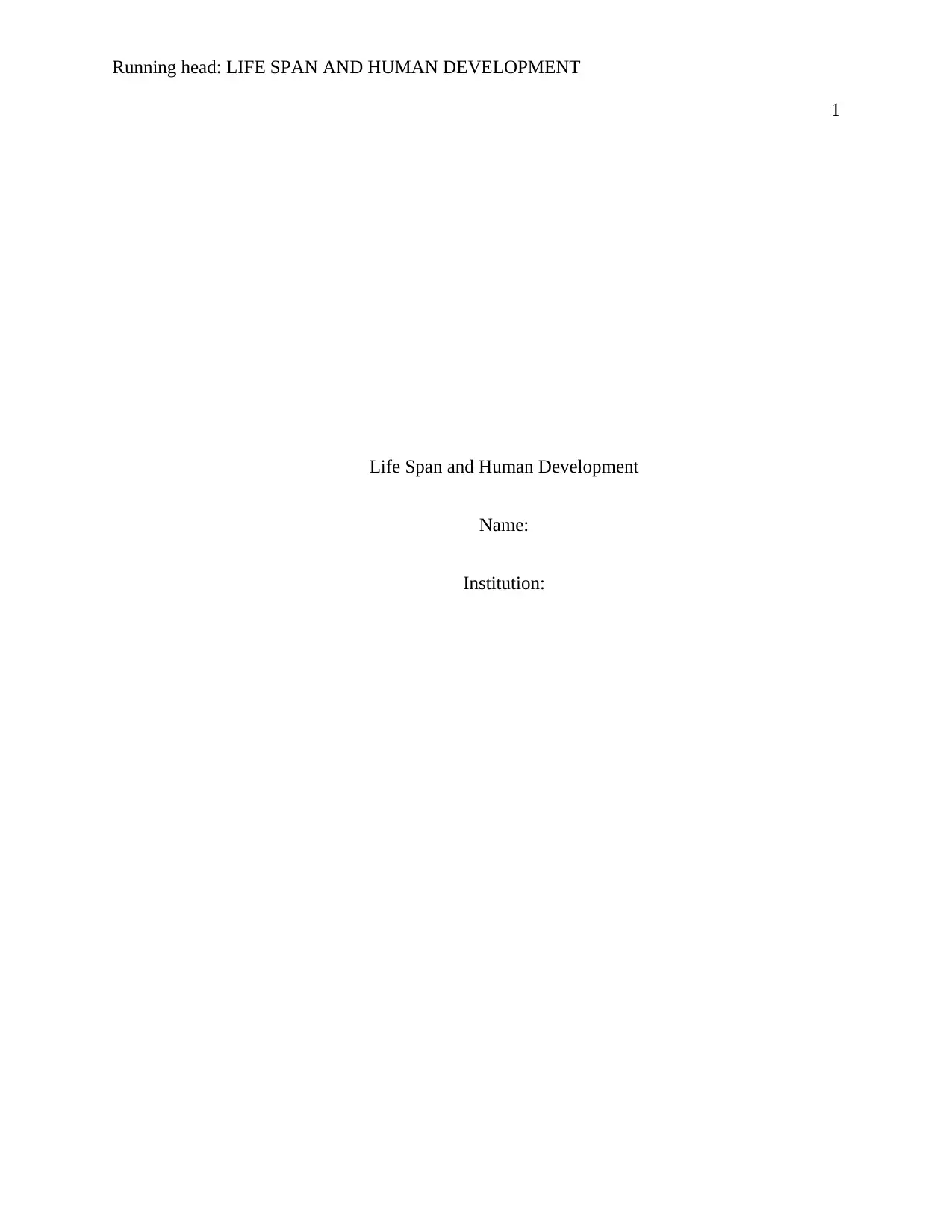
Running head: LIFE SPAN AND HUMAN DEVELOPMENT
1
Life Span and Human Development
Name:
Institution:
1
Life Span and Human Development
Name:
Institution:
Paraphrase This Document
Need a fresh take? Get an instant paraphrase of this document with our AI Paraphraser
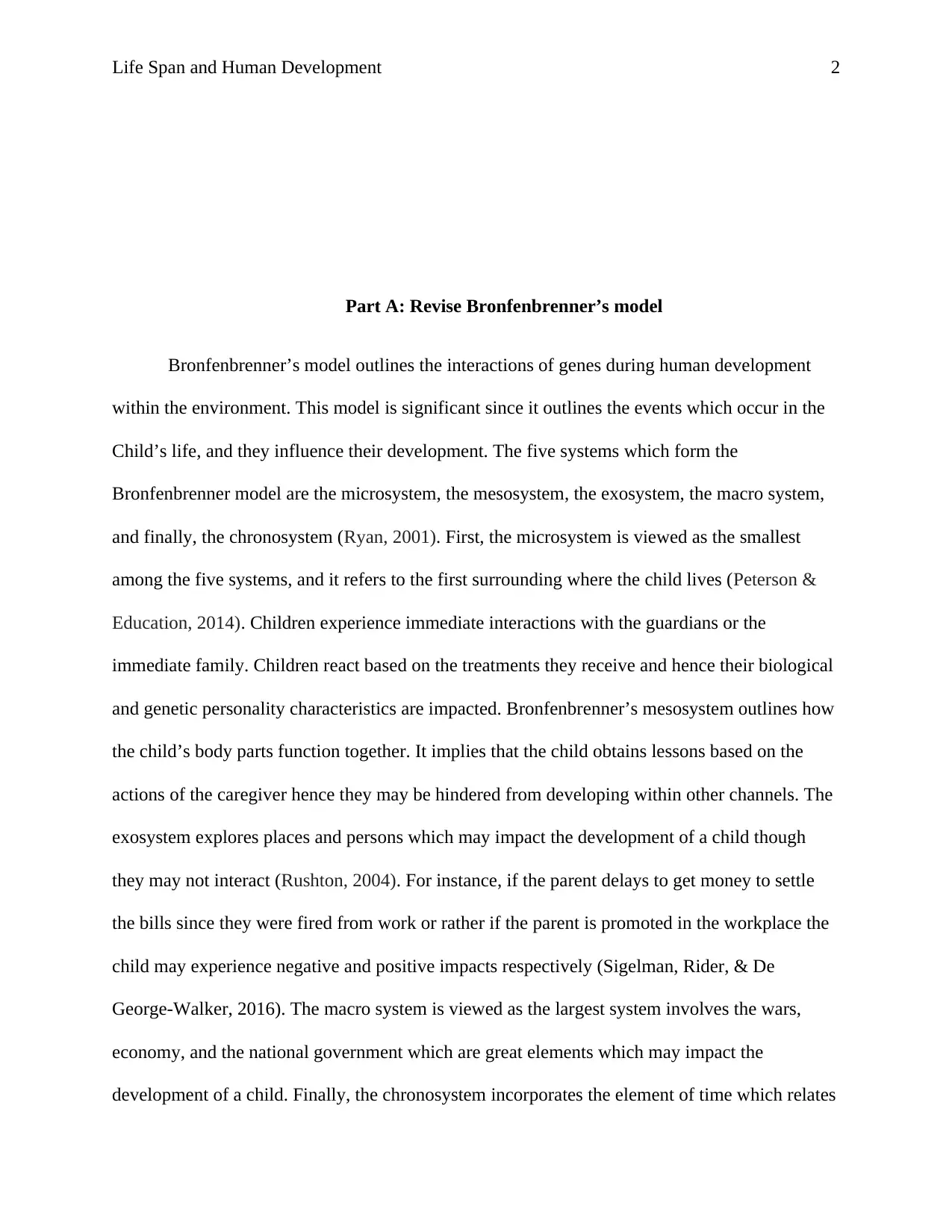
Life Span and Human Development 2
Part A: Revise Bronfenbrenner’s model
Bronfenbrenner’s model outlines the interactions of genes during human development
within the environment. This model is significant since it outlines the events which occur in the
Child’s life, and they influence their development. The five systems which form the
Bronfenbrenner model are the microsystem, the mesosystem, the exosystem, the macro system,
and finally, the chronosystem (Ryan, 2001). First, the microsystem is viewed as the smallest
among the five systems, and it refers to the first surrounding where the child lives (Peterson &
Education, 2014). Children experience immediate interactions with the guardians or the
immediate family. Children react based on the treatments they receive and hence their biological
and genetic personality characteristics are impacted. Bronfenbrenner’s mesosystem outlines how
the child’s body parts function together. It implies that the child obtains lessons based on the
actions of the caregiver hence they may be hindered from developing within other channels. The
exosystem explores places and persons which may impact the development of a child though
they may not interact (Rushton, 2004). For instance, if the parent delays to get money to settle
the bills since they were fired from work or rather if the parent is promoted in the workplace the
child may experience negative and positive impacts respectively (Sigelman, Rider, & De
George-Walker, 2016). The macro system is viewed as the largest system involves the wars,
economy, and the national government which are great elements which may impact the
development of a child. Finally, the chronosystem incorporates the element of time which relates
Part A: Revise Bronfenbrenner’s model
Bronfenbrenner’s model outlines the interactions of genes during human development
within the environment. This model is significant since it outlines the events which occur in the
Child’s life, and they influence their development. The five systems which form the
Bronfenbrenner model are the microsystem, the mesosystem, the exosystem, the macro system,
and finally, the chronosystem (Ryan, 2001). First, the microsystem is viewed as the smallest
among the five systems, and it refers to the first surrounding where the child lives (Peterson &
Education, 2014). Children experience immediate interactions with the guardians or the
immediate family. Children react based on the treatments they receive and hence their biological
and genetic personality characteristics are impacted. Bronfenbrenner’s mesosystem outlines how
the child’s body parts function together. It implies that the child obtains lessons based on the
actions of the caregiver hence they may be hindered from developing within other channels. The
exosystem explores places and persons which may impact the development of a child though
they may not interact (Rushton, 2004). For instance, if the parent delays to get money to settle
the bills since they were fired from work or rather if the parent is promoted in the workplace the
child may experience negative and positive impacts respectively (Sigelman, Rider, & De
George-Walker, 2016). The macro system is viewed as the largest system involves the wars,
economy, and the national government which are great elements which may impact the
development of a child. Finally, the chronosystem incorporates the element of time which relates
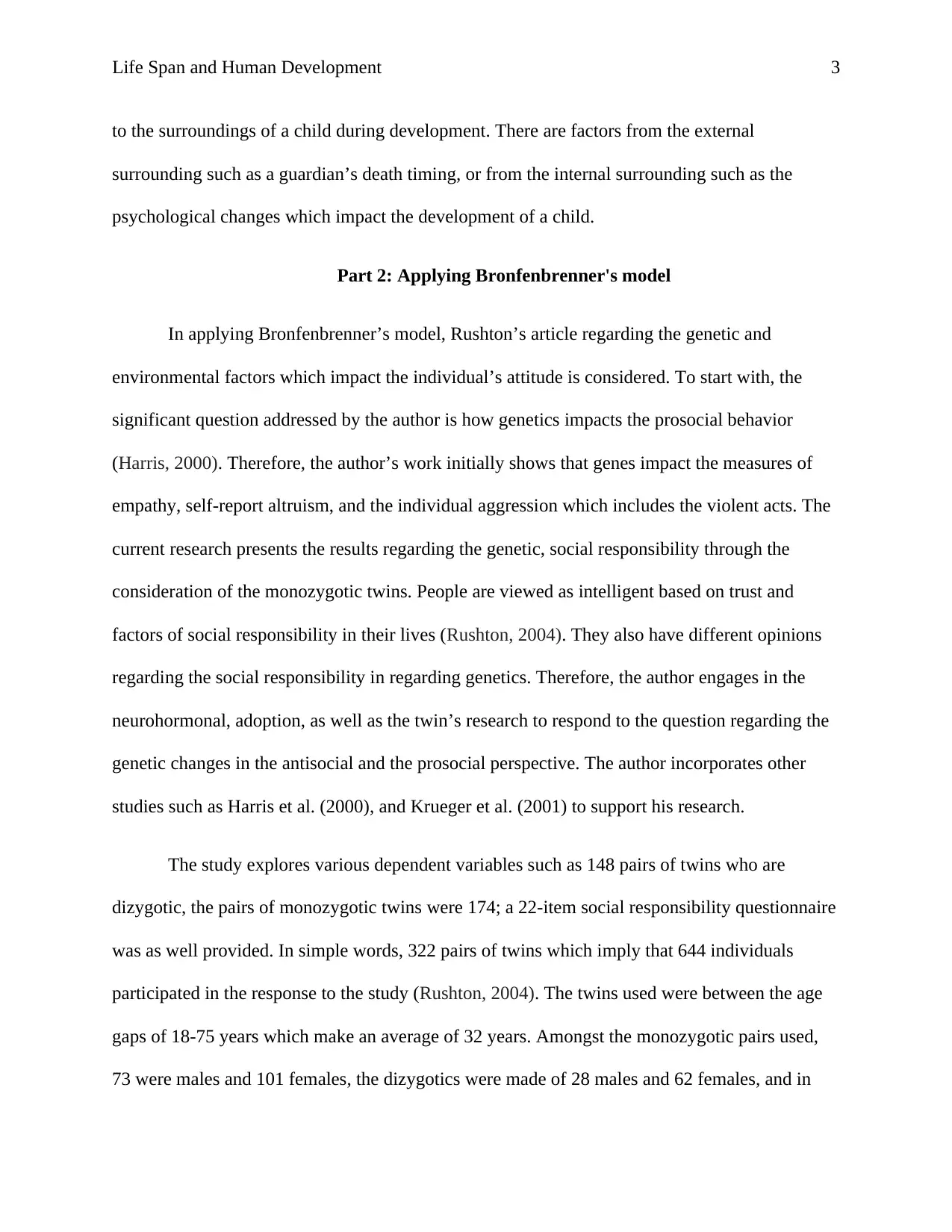
Life Span and Human Development 3
to the surroundings of a child during development. There are factors from the external
surrounding such as a guardian’s death timing, or from the internal surrounding such as the
psychological changes which impact the development of a child.
Part 2: Applying Bronfenbrenner's model
In applying Bronfenbrenner’s model, Rushton’s article regarding the genetic and
environmental factors which impact the individual’s attitude is considered. To start with, the
significant question addressed by the author is how genetics impacts the prosocial behavior
(Harris, 2000). Therefore, the author’s work initially shows that genes impact the measures of
empathy, self-report altruism, and the individual aggression which includes the violent acts. The
current research presents the results regarding the genetic, social responsibility through the
consideration of the monozygotic twins. People are viewed as intelligent based on trust and
factors of social responsibility in their lives (Rushton, 2004). They also have different opinions
regarding the social responsibility in regarding genetics. Therefore, the author engages in the
neurohormonal, adoption, as well as the twin’s research to respond to the question regarding the
genetic changes in the antisocial and the prosocial perspective. The author incorporates other
studies such as Harris et al. (2000), and Krueger et al. (2001) to support his research.
The study explores various dependent variables such as 148 pairs of twins who are
dizygotic, the pairs of monozygotic twins were 174; a 22-item social responsibility questionnaire
was as well provided. In simple words, 322 pairs of twins which imply that 644 individuals
participated in the response to the study (Rushton, 2004). The twins used were between the age
gaps of 18-75 years which make an average of 32 years. Amongst the monozygotic pairs used,
73 were males and 101 females, the dizygotics were made of 28 males and 62 females, and in
to the surroundings of a child during development. There are factors from the external
surrounding such as a guardian’s death timing, or from the internal surrounding such as the
psychological changes which impact the development of a child.
Part 2: Applying Bronfenbrenner's model
In applying Bronfenbrenner’s model, Rushton’s article regarding the genetic and
environmental factors which impact the individual’s attitude is considered. To start with, the
significant question addressed by the author is how genetics impacts the prosocial behavior
(Harris, 2000). Therefore, the author’s work initially shows that genes impact the measures of
empathy, self-report altruism, and the individual aggression which includes the violent acts. The
current research presents the results regarding the genetic, social responsibility through the
consideration of the monozygotic twins. People are viewed as intelligent based on trust and
factors of social responsibility in their lives (Rushton, 2004). They also have different opinions
regarding the social responsibility in regarding genetics. Therefore, the author engages in the
neurohormonal, adoption, as well as the twin’s research to respond to the question regarding the
genetic changes in the antisocial and the prosocial perspective. The author incorporates other
studies such as Harris et al. (2000), and Krueger et al. (2001) to support his research.
The study explores various dependent variables such as 148 pairs of twins who are
dizygotic, the pairs of monozygotic twins were 174; a 22-item social responsibility questionnaire
was as well provided. In simple words, 322 pairs of twins which imply that 644 individuals
participated in the response to the study (Rushton, 2004). The twins used were between the age
gaps of 18-75 years which make an average of 32 years. Amongst the monozygotic pairs used,
73 were males and 101 females, the dizygotics were made of 28 males and 62 females, and in
⊘ This is a preview!⊘
Do you want full access?
Subscribe today to unlock all pages.

Trusted by 1+ million students worldwide
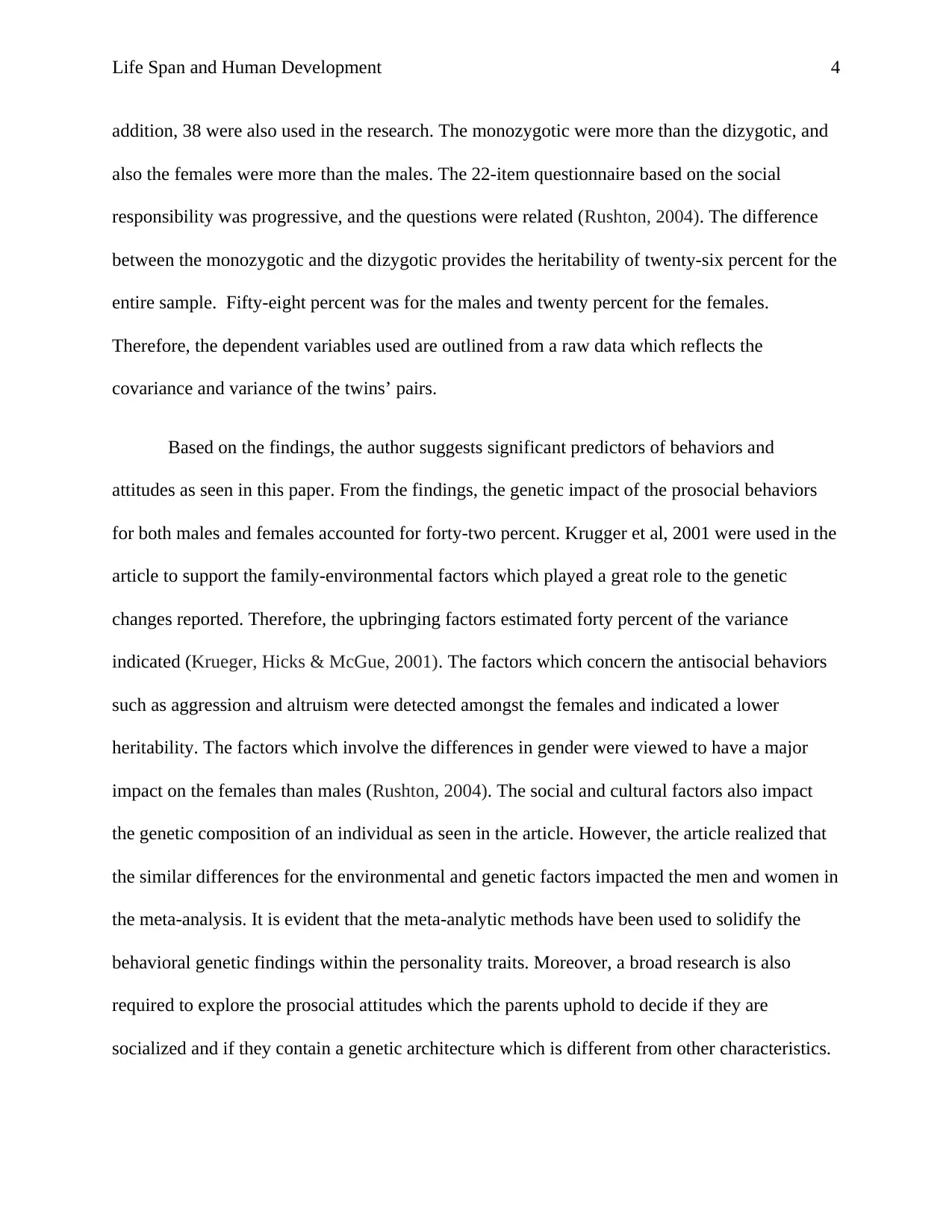
Life Span and Human Development 4
addition, 38 were also used in the research. The monozygotic were more than the dizygotic, and
also the females were more than the males. The 22-item questionnaire based on the social
responsibility was progressive, and the questions were related (Rushton, 2004). The difference
between the monozygotic and the dizygotic provides the heritability of twenty-six percent for the
entire sample. Fifty-eight percent was for the males and twenty percent for the females.
Therefore, the dependent variables used are outlined from a raw data which reflects the
covariance and variance of the twins’ pairs.
Based on the findings, the author suggests significant predictors of behaviors and
attitudes as seen in this paper. From the findings, the genetic impact of the prosocial behaviors
for both males and females accounted for forty-two percent. Krugger et al, 2001 were used in the
article to support the family-environmental factors which played a great role to the genetic
changes reported. Therefore, the upbringing factors estimated forty percent of the variance
indicated (Krueger, Hicks & McGue, 2001). The factors which concern the antisocial behaviors
such as aggression and altruism were detected amongst the females and indicated a lower
heritability. The factors which involve the differences in gender were viewed to have a major
impact on the females than males (Rushton, 2004). The social and cultural factors also impact
the genetic composition of an individual as seen in the article. However, the article realized that
the similar differences for the environmental and genetic factors impacted the men and women in
the meta-analysis. It is evident that the meta-analytic methods have been used to solidify the
behavioral genetic findings within the personality traits. Moreover, a broad research is also
required to explore the prosocial attitudes which the parents uphold to decide if they are
socialized and if they contain a genetic architecture which is different from other characteristics.
addition, 38 were also used in the research. The monozygotic were more than the dizygotic, and
also the females were more than the males. The 22-item questionnaire based on the social
responsibility was progressive, and the questions were related (Rushton, 2004). The difference
between the monozygotic and the dizygotic provides the heritability of twenty-six percent for the
entire sample. Fifty-eight percent was for the males and twenty percent for the females.
Therefore, the dependent variables used are outlined from a raw data which reflects the
covariance and variance of the twins’ pairs.
Based on the findings, the author suggests significant predictors of behaviors and
attitudes as seen in this paper. From the findings, the genetic impact of the prosocial behaviors
for both males and females accounted for forty-two percent. Krugger et al, 2001 were used in the
article to support the family-environmental factors which played a great role to the genetic
changes reported. Therefore, the upbringing factors estimated forty percent of the variance
indicated (Krueger, Hicks & McGue, 2001). The factors which concern the antisocial behaviors
such as aggression and altruism were detected amongst the females and indicated a lower
heritability. The factors which involve the differences in gender were viewed to have a major
impact on the females than males (Rushton, 2004). The social and cultural factors also impact
the genetic composition of an individual as seen in the article. However, the article realized that
the similar differences for the environmental and genetic factors impacted the men and women in
the meta-analysis. It is evident that the meta-analytic methods have been used to solidify the
behavioral genetic findings within the personality traits. Moreover, a broad research is also
required to explore the prosocial attitudes which the parents uphold to decide if they are
socialized and if they contain a genetic architecture which is different from other characteristics.
Paraphrase This Document
Need a fresh take? Get an instant paraphrase of this document with our AI Paraphraser
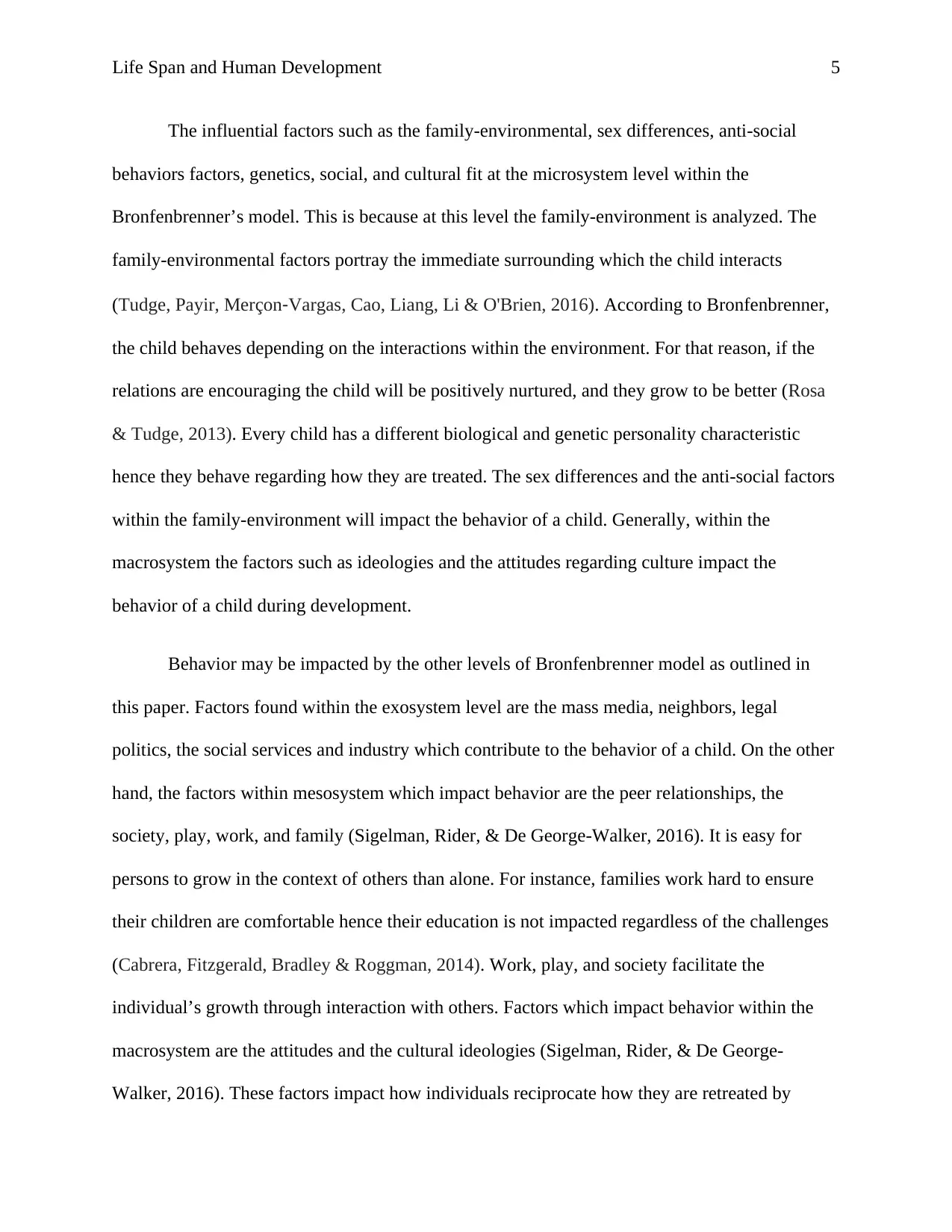
Life Span and Human Development 5
The influential factors such as the family-environmental, sex differences, anti-social
behaviors factors, genetics, social, and cultural fit at the microsystem level within the
Bronfenbrenner’s model. This is because at this level the family-environment is analyzed. The
family-environmental factors portray the immediate surrounding which the child interacts
(Tudge, Payir, Merçon‐Vargas, Cao, Liang, Li & O'Brien, 2016). According to Bronfenbrenner,
the child behaves depending on the interactions within the environment. For that reason, if the
relations are encouraging the child will be positively nurtured, and they grow to be better (Rosa
& Tudge, 2013). Every child has a different biological and genetic personality characteristic
hence they behave regarding how they are treated. The sex differences and the anti-social factors
within the family-environment will impact the behavior of a child. Generally, within the
macrosystem the factors such as ideologies and the attitudes regarding culture impact the
behavior of a child during development.
Behavior may be impacted by the other levels of Bronfenbrenner model as outlined in
this paper. Factors found within the exosystem level are the mass media, neighbors, legal
politics, the social services and industry which contribute to the behavior of a child. On the other
hand, the factors within mesosystem which impact behavior are the peer relationships, the
society, play, work, and family (Sigelman, Rider, & De George-Walker, 2016). It is easy for
persons to grow in the context of others than alone. For instance, families work hard to ensure
their children are comfortable hence their education is not impacted regardless of the challenges
(Cabrera, Fitzgerald, Bradley & Roggman, 2014). Work, play, and society facilitate the
individual’s growth through interaction with others. Factors which impact behavior within the
macrosystem are the attitudes and the cultural ideologies (Sigelman, Rider, & De George-
Walker, 2016). These factors impact how individuals reciprocate how they are retreated by
The influential factors such as the family-environmental, sex differences, anti-social
behaviors factors, genetics, social, and cultural fit at the microsystem level within the
Bronfenbrenner’s model. This is because at this level the family-environment is analyzed. The
family-environmental factors portray the immediate surrounding which the child interacts
(Tudge, Payir, Merçon‐Vargas, Cao, Liang, Li & O'Brien, 2016). According to Bronfenbrenner,
the child behaves depending on the interactions within the environment. For that reason, if the
relations are encouraging the child will be positively nurtured, and they grow to be better (Rosa
& Tudge, 2013). Every child has a different biological and genetic personality characteristic
hence they behave regarding how they are treated. The sex differences and the anti-social factors
within the family-environment will impact the behavior of a child. Generally, within the
macrosystem the factors such as ideologies and the attitudes regarding culture impact the
behavior of a child during development.
Behavior may be impacted by the other levels of Bronfenbrenner model as outlined in
this paper. Factors found within the exosystem level are the mass media, neighbors, legal
politics, the social services and industry which contribute to the behavior of a child. On the other
hand, the factors within mesosystem which impact behavior are the peer relationships, the
society, play, work, and family (Sigelman, Rider, & De George-Walker, 2016). It is easy for
persons to grow in the context of others than alone. For instance, families work hard to ensure
their children are comfortable hence their education is not impacted regardless of the challenges
(Cabrera, Fitzgerald, Bradley & Roggman, 2014). Work, play, and society facilitate the
individual’s growth through interaction with others. Factors which impact behavior within the
macrosystem are the attitudes and the cultural ideologies (Sigelman, Rider, & De George-
Walker, 2016). These factors impact how individuals reciprocate how they are retreated by
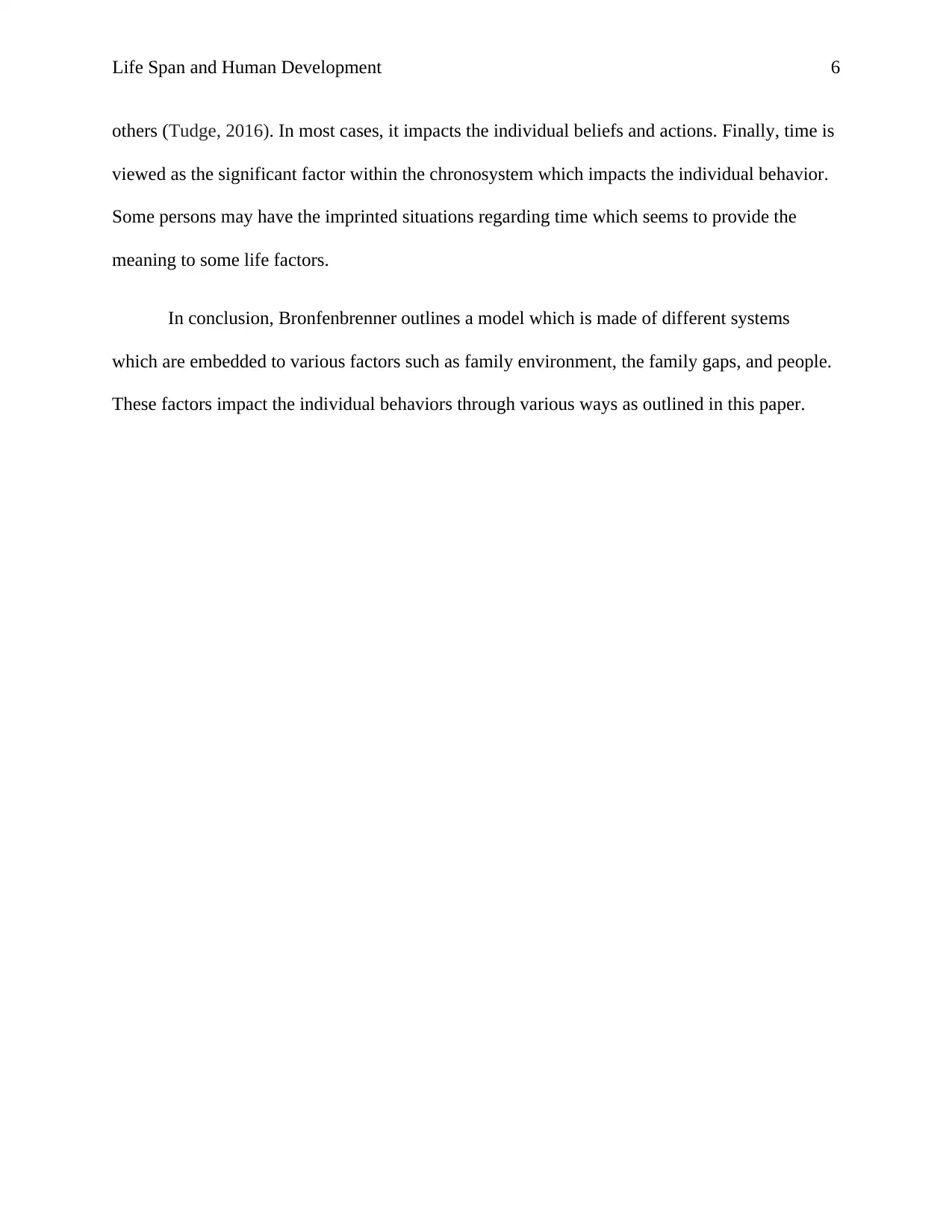
Life Span and Human Development 6
others (Tudge, 2016). In most cases, it impacts the individual beliefs and actions. Finally, time is
viewed as the significant factor within the chronosystem which impacts the individual behavior.
Some persons may have the imprinted situations regarding time which seems to provide the
meaning to some life factors.
In conclusion, Bronfenbrenner outlines a model which is made of different systems
which are embedded to various factors such as family environment, the family gaps, and people.
These factors impact the individual behaviors through various ways as outlined in this paper.
others (Tudge, 2016). In most cases, it impacts the individual beliefs and actions. Finally, time is
viewed as the significant factor within the chronosystem which impacts the individual behavior.
Some persons may have the imprinted situations regarding time which seems to provide the
meaning to some life factors.
In conclusion, Bronfenbrenner outlines a model which is made of different systems
which are embedded to various factors such as family environment, the family gaps, and people.
These factors impact the individual behaviors through various ways as outlined in this paper.
⊘ This is a preview!⊘
Do you want full access?
Subscribe today to unlock all pages.

Trusted by 1+ million students worldwide
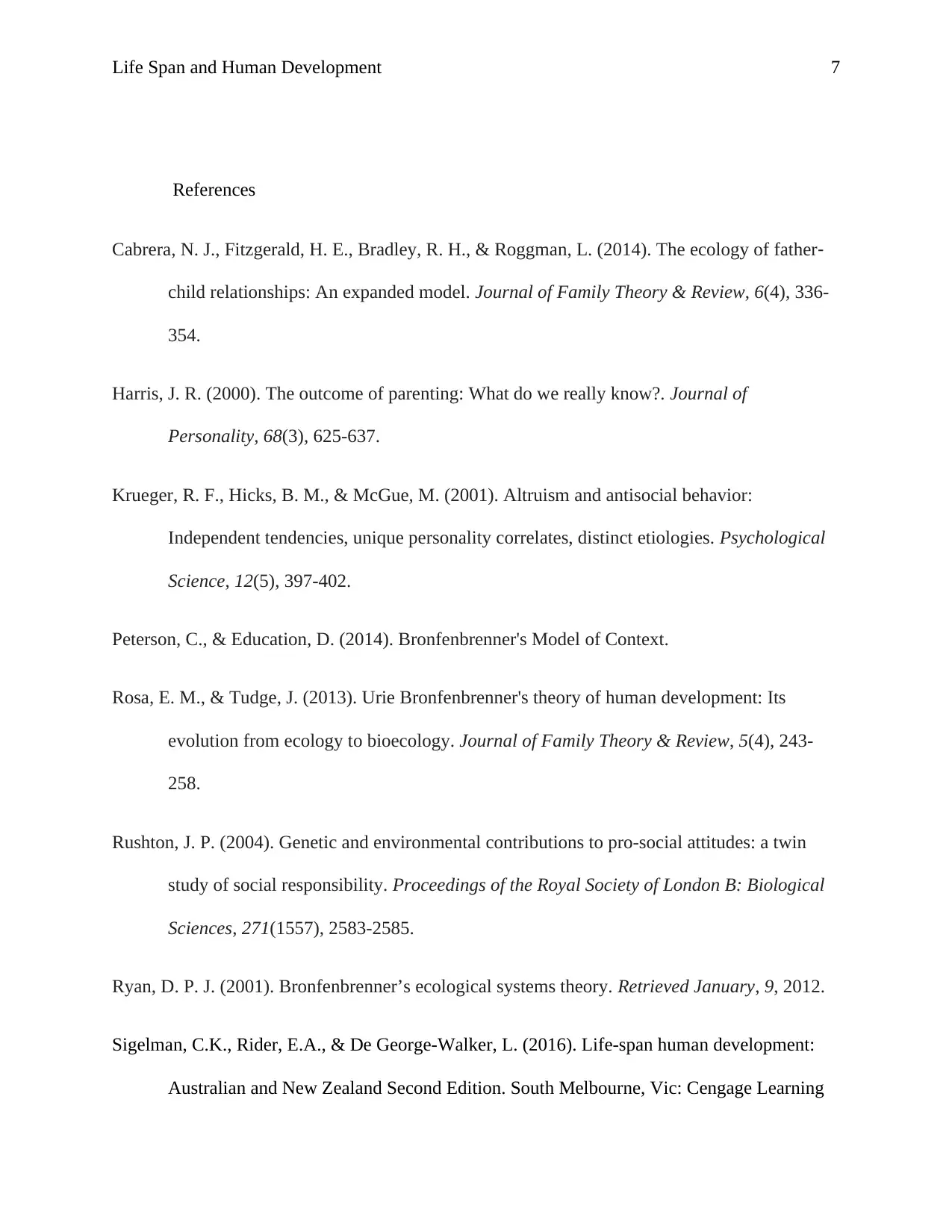
Life Span and Human Development 7
References
Cabrera, N. J., Fitzgerald, H. E., Bradley, R. H., & Roggman, L. (2014). The ecology of father‐
child relationships: An expanded model. Journal of Family Theory & Review, 6(4), 336-
354.
Harris, J. R. (2000). The outcome of parenting: What do we really know?. Journal of
Personality, 68(3), 625-637.
Krueger, R. F., Hicks, B. M., & McGue, M. (2001). Altruism and antisocial behavior:
Independent tendencies, unique personality correlates, distinct etiologies. Psychological
Science, 12(5), 397-402.
Peterson, C., & Education, D. (2014). Bronfenbrenner's Model of Context.
Rosa, E. M., & Tudge, J. (2013). Urie Bronfenbrenner's theory of human development: Its
evolution from ecology to bioecology. Journal of Family Theory & Review, 5(4), 243-
258.
Rushton, J. P. (2004). Genetic and environmental contributions to pro-social attitudes: a twin
study of social responsibility. Proceedings of the Royal Society of London B: Biological
Sciences, 271(1557), 2583-2585.
Ryan, D. P. J. (2001). Bronfenbrenner’s ecological systems theory. Retrieved January, 9, 2012.
Sigelman, C.K., Rider, E.A., & De George-Walker, L. (2016). Life-span human development:
Australian and New Zealand Second Edition. South Melbourne, Vic: Cengage Learning
References
Cabrera, N. J., Fitzgerald, H. E., Bradley, R. H., & Roggman, L. (2014). The ecology of father‐
child relationships: An expanded model. Journal of Family Theory & Review, 6(4), 336-
354.
Harris, J. R. (2000). The outcome of parenting: What do we really know?. Journal of
Personality, 68(3), 625-637.
Krueger, R. F., Hicks, B. M., & McGue, M. (2001). Altruism and antisocial behavior:
Independent tendencies, unique personality correlates, distinct etiologies. Psychological
Science, 12(5), 397-402.
Peterson, C., & Education, D. (2014). Bronfenbrenner's Model of Context.
Rosa, E. M., & Tudge, J. (2013). Urie Bronfenbrenner's theory of human development: Its
evolution from ecology to bioecology. Journal of Family Theory & Review, 5(4), 243-
258.
Rushton, J. P. (2004). Genetic and environmental contributions to pro-social attitudes: a twin
study of social responsibility. Proceedings of the Royal Society of London B: Biological
Sciences, 271(1557), 2583-2585.
Ryan, D. P. J. (2001). Bronfenbrenner’s ecological systems theory. Retrieved January, 9, 2012.
Sigelman, C.K., Rider, E.A., & De George-Walker, L. (2016). Life-span human development:
Australian and New Zealand Second Edition. South Melbourne, Vic: Cengage Learning
Paraphrase This Document
Need a fresh take? Get an instant paraphrase of this document with our AI Paraphraser
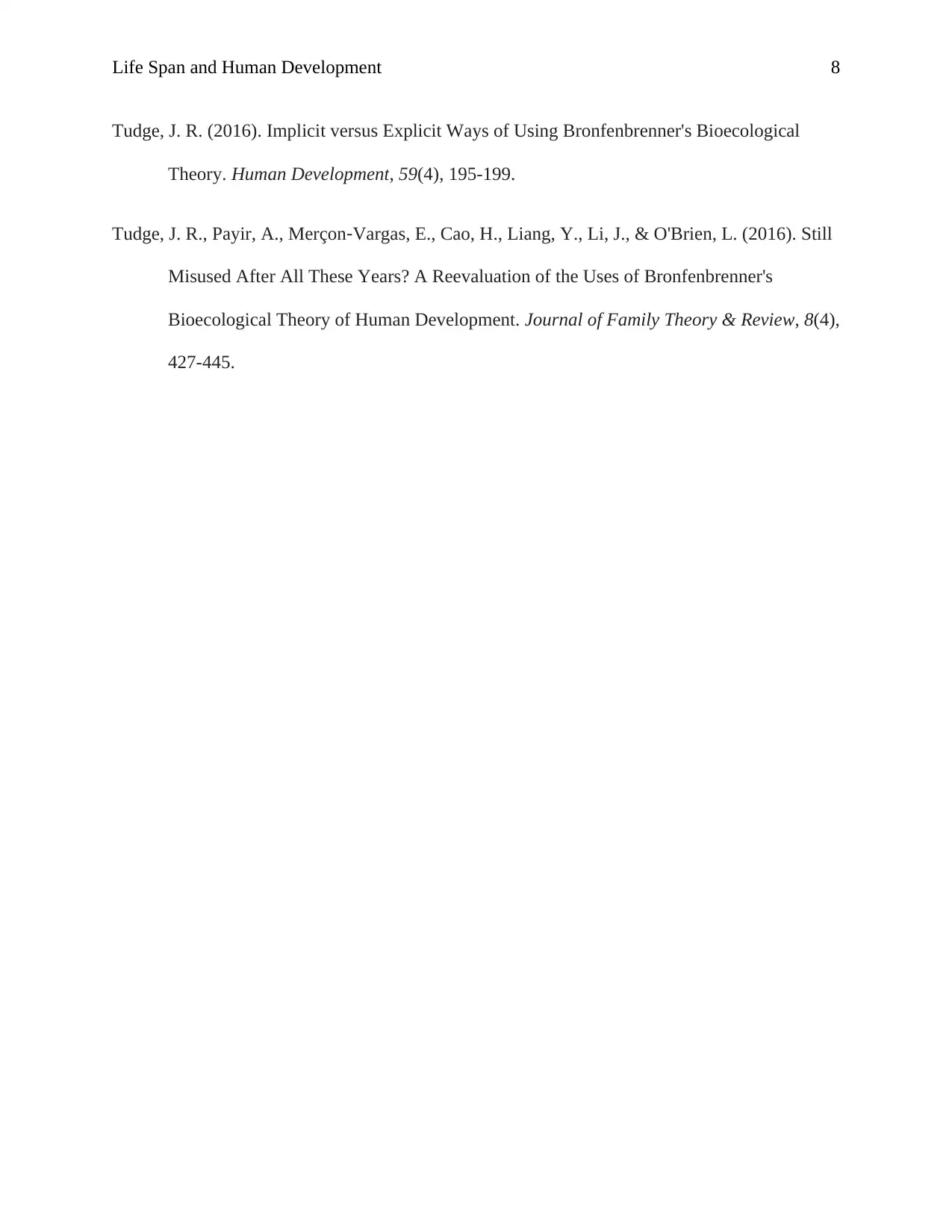
Life Span and Human Development 8
Tudge, J. R. (2016). Implicit versus Explicit Ways of Using Bronfenbrenner's Bioecological
Theory. Human Development, 59(4), 195-199.
Tudge, J. R., Payir, A., Merçon‐Vargas, E., Cao, H., Liang, Y., Li, J., & O'Brien, L. (2016). Still
Misused After All These Years? A Reevaluation of the Uses of Bronfenbrenner's
Bioecological Theory of Human Development. Journal of Family Theory & Review, 8(4),
427-445.
Tudge, J. R. (2016). Implicit versus Explicit Ways of Using Bronfenbrenner's Bioecological
Theory. Human Development, 59(4), 195-199.
Tudge, J. R., Payir, A., Merçon‐Vargas, E., Cao, H., Liang, Y., Li, J., & O'Brien, L. (2016). Still
Misused After All These Years? A Reevaluation of the Uses of Bronfenbrenner's
Bioecological Theory of Human Development. Journal of Family Theory & Review, 8(4),
427-445.
1 out of 8
Your All-in-One AI-Powered Toolkit for Academic Success.
+13062052269
info@desklib.com
Available 24*7 on WhatsApp / Email
![[object Object]](/_next/static/media/star-bottom.7253800d.svg)
Unlock your academic potential
Copyright © 2020–2025 A2Z Services. All Rights Reserved. Developed and managed by ZUCOL.

![Ecological Systems Theory and Child Development Essay, [University]](/_next/image/?url=https%3A%2F%2Fdesklib.com%2Fmedia%2Fimages%2Fzr%2Ff9a594fb207243969d0a32ecfd8ad4a4.jpg&w=256&q=75)
